Summer
El Nino on The Way; Long Range Models Are Still Freaking Out
15
May, 2015
Well,
it’s official. According
to NOAA’s May 14 update,
we are now looking at a 90 percent chance that El Nino conditions
prevail through Northern Hemisphere Summer and a greater than 80
percent chance El Nino will last throughout all of 2015:
(Climate
Prediction Center’s ENSO probability forecast shows 90 percent
chance of El Nino through June, July and August and a greater than 80
percent chance that El Nino continues on through to the end of this
year. Image source: CPC/IRI.)
What
this means, especially when we add in likely record warm global
atmospheric temperatures (due to an excessive burning of fossil fuels
by human beings) throughout the El Nino event period, is some rather
odd, and probably extreme summer weather.
For
the US, it means an increasing likelihood of heavy precipitation
events from the southern plains states through the desert southwest.
Storm track intensification through the Pacific to North America
means that extreme rainfall events are a distinct possibility for
states like Texas, Oklahoma, Colorado, Arizona, Nevada, and New
Mexico. California may even see some abnormal summer rainfall, taking
a bit of the edge off the current drought.
Moving
southward, we find drier conditions for equatorial South America and
warmer than normal conditions for much of Brazil and Chile. Northern
Hemisphere Summer El Nino also enhances the risk of drought
throughout Australia, Southeast Asia, and India. In particular, India
is vulnerable to monsoonal disruption due to emergence of El Nino
during summer time. Enhanced precipitation near the date line also
can spur increased cyclone development for the Western Pacific.
(A
geographic representation of major prevailing summer El Nino
teleconnections. Image source: Berkley.)
These
sets of atmospheric changes are what we could generally expect from a
typical El Nino emerging throughout Northern Hemisphere summer. But
we’re not really dealing with normal conditions. We’re dealing
with global temperatures in the range of +0.8 degrees C above 20th
Century averages and + 1 C above 1880s averages. As such, we should
probably look to the margins for potential added impact.
Two
areas in particular come to mind when considering such outliers. The
first region is a zone from Ukraine through to Western Russia. Under
added human heat forcing and conditions prevalent during summer El
Ninos, this region shows an increased likelihood of drought and
heatwave. A vulnerability that became particularly apparent during
the El Nino of 2009-2010. Drought conditions are somewhat widespread
for that region already this year. In addition, atmospheric high
pressure development in this vulnerable area would now, with the
enhanced surface warming due to human heat forcing, telegraph into
the Arctic through a vulnerable zone near Yamal and the Kara and
Laptev Seas. This would particularly enhance snow melt, permafrost
thaw, and sea ice melt throughout this region. So with El Nino now a
summertime certainty, this broader area certainly bears watching.
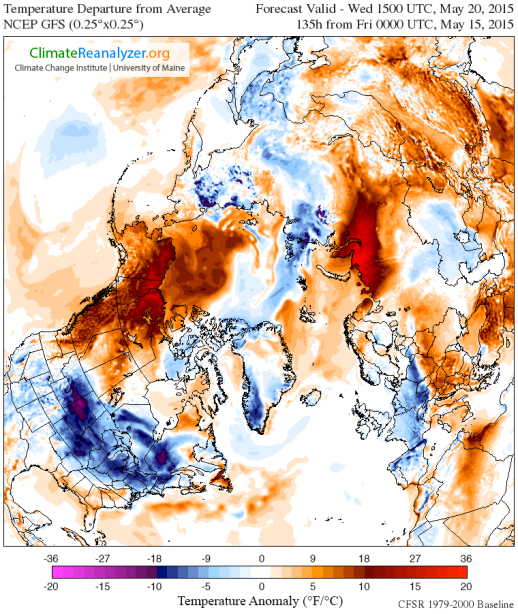
(El
Nino teleconnection to warming in Northwestern North America through
to the Arctic Ocean and in regions of Central, Western and Northern
Asia are possible this summer. Above is a GFS model forecast
temperature anomaly summary provided by The University of
Maine’s Climate
Reanalyzer.)
The
second region to look out for is the zone ranging from Northwest
Canada through Alaska and on into the Chukchi and Beaufort Seas.
Summer El Ninos tend to enhance warming for this region. When adding
in an already persistent heating throughout 2015 winter and spring,
the area will fall under greatly heightened risk of severe wildfires
and extreme and early snow and sea ice melt. Early extreme wildfires
in British Columbia combined with rapid sea ice recession already
ongoing through the Beaufort and Chukchi may well be indications that
such a trend has already asserted.
Some
Long Range Models Are Still Freaking Out Over a Potential Monster El
Nino Later This Year
Moving
beyond summer, we find a wide range of model consensus estimates
showing strong El Nino by fall and winter of this year. NINO 3.4
departures from an average of global model ensembles compiled
by Weather Underground hit
a value of +1.7 C by September. A level just below the so-called
Super El Nino Threshold of +1.8 C.
NOAA
CFSv2 ensembles have continued to ramp higher. Weighted seasonal
means have now spiked to +2.75 C for the key NINO 3.4 region with
unweighted ensembles hitting +3 C for October, November and December.
Weighted monthly means have spiked to +3 C anomaly for November while
unweighted anomaly values for the same month have proceeded off the
charts to an implied +3.5 C:
(Some
El Nino forecast models, like the one above, are really freaking out
about the potential for a monster event by the end of this year. This
NOAA model is basically off the charts. Image source: NOAA’s
Climate Prediction Center.)
Should
these predicted values emerge, they will literally blow the 1998-1999
Super El Nino out of the water. A monster event to shatter all
records.
It’s
likely that the currently extreme subsurface temperatures due to a
very strong warm Kelvin Wave as well as continued powerful west wind
back-bursts have kicked these models into freak out mode. And it’s
certainly an issue worth keeping an eye on.
But
it’s also worthwhile to consider that global deep ocean and
atmospheric dynamics will push to cool equatorial Pacific waters
during September, which would tend to tamp down warming extremes. A
factor that many models, which measure the shallow water zone
primarily, tend to miss.
“What
happens after this Kelvin wave response is all over the place. This
El Niño is being fought by the annual cycle, which tries to make
SSTs cold by Sept-Oct. That tendency keeps the warmest waters
back near the International Date Line and cuts off the Bjerknes
feedback. If the SSTs develop to be big enough to overcome the
annual cycle tendencies, then the Bjerknes feedback can kick in.”
For
reference, Bjerknes feedback involves storm formation and subsequent
west wind backbursts east of the Date Line and on toward South
America. A feedback that tends to trap and channel ocean surface heat
into the relevant El Nino zones and generally enhance warm sea
surface temperature anomalies:
(Graphic
illustration of Bjerknes feedback showing sea surface temperature
anomalies in the color measure and direction of wind flow indicated
by black lines. It’s feature influenced by a general shoving of the
Walker Cell eastward [implied but not shown]. Image source: ENSO
as an Integrating Concept of Earth Science.)
So,
at this point, we have a lock on a weak to moderate El Nino event
continuing through this summer. After that time, an unprecedentedly
warm Kelvin Wave will do battle with a seasonal tendency for cooling
in the Eastern Equatorial Pacific. And if it wins out, we may see
something never before recorded in the whole of the Earth Sciences —
which would be very bad news for rates of global surface temperature
increase this year, along with a huge number of other issues.
If
not, we likely have a mid ocean El Nino through Fall and Autumn. And
that may be bad news for a California desperately in need of drought
relief.
Links:
A
Rare Mid-Year El Niño Event Is Strengthening
By:
Bob Henson
14
May, 2015
The
robust El Niño event anticipated for more than a year is finally
coming to fruition, according to the latest observations and
forecasts. NOAA's latest monthly
analysis,
issued on Thursday morning, continues the El Niño Advisory already
in effect and calls for a 90% chance of El Niño conditions
persisting through the summer, with a greater-than-80% chance they
will continue through the end of 2015. These are the highest
probabilities yet for the current event, and a sign of increased
forecaster confidence--despite the fact that we're in northern
spring, the very time when El Niño outlooks are most uncertain.

Figure
1. A schematic showing the processes involved in El Niño. The trade
winds shown by the arrow are weaker at this point than during La Niña
or neutral conditions; at certain times and at some locations, they
may even reverse, blowing from west to east. For a full explanation
of the El Niño-Southern Oscillation, including additional graphics,
see the website published by the Australian
Bureau of Meteorology.
Image credit: BOM.
Forecasters
and computer models alike have been confounded by this event. In a
classic El Niño, the ocean and atmosphere are synchronized in a
mutually reinforcing pattern that pushes warm sea-surface
temperatures (SSTs) and thunderstorm activity along the equator
eastward for thousands of miles, from Indonesia toward South America
(see Figure 1). Sometimes the atmosphere doesn't respond to a "kick"
from the ocean, and an embryonic El Niño fails to develop. This was
the case last spring, when a powerful oceanic Kelvin wave (a broad,
shallow, slow-moving impulse) pushed warm water east across the
Pacific tropics. Keying off this wave, many of the global models used
in El Niño prediction called for a moderate or even strong El Niño
by the fall of 2014. However, the normal east-to-west trade winds
never reversed, which helped torpedo the needed ocean-atmosphere
synchrony. The ocean tried again last fall with another Kelvin wave,
but again the atmosphere failed to respond, and the SST warming
disappeared after a few weeks.

Figure
2. Recent weekly departures from normal across the four tropical
Pacific regions (top map) that are regularly monitored for signs of
El Niño and La Niña. Image credit: NOAA
Climate Prediction Center.
This
time, things appear to be different: SSTs have warmed for the last
several months, and more recently, trade winds have weakened. As of
Monday, the weekly-averaged SSTs over the four regions monitored for
El Niño were all at least 1.0°C above average (see Figure 2,
right). If the values
for all four regions
can sustain this feat throughout the next month, it'll be the first
time this has happened since November 1997, during the strongest El
Niño event of the 20th century. Just as significant, the
persistently warmer-than-normal SSTs over the western tropical
Pacific have now cooled, which helps support the reversal of trade
winds so critical to El Niño. The current SST map now resembles a
more textbook-like El Niño signature (see Figure 3, below), and
there is every indication that the ocean-atmosphere coupling will now
continue to grow.
An
event out of season
As
far as the eastern tropical Pacific goes, it's beginning to look a
lot like Christmas. El Niño--"the Christ child" in
Spanish--gets its name from its tendency to bring above-average SSTs
to the coasts of Peru and Ecuador around Christmastime. The
climatology of the eastern Pacific tends to support El Niño and La
Niña development during the northern autumn, maximum strength in the
winter, and decay in the spring. The current event is thus bucking
climatology as it continues into northern spring. The three-month
departure from average in the Niño3.4 region reached the El Niño
threshold of +0.5°C in Oct-Nov-Jan 2014-15, and it's hovered in the
weak range (+0.5 to +1.0°C] ever since, with a value of +0.6°C for
Feb-Mar-Apr 2015. Only 12 of the 65 prior years in the historical
database of El Niño/Southern Oscillation (ENSO) events
have seen a value of at least +0.5°C during the Feb-Mar-Apr period.
Water temperatures in the Niño3.4 region are normally
at their warmest in May,
so the current warm anomaly is leading to especially toasty SSTs of
around 29°C (84°F). If this El Niño event does intensify, as
models strongly suggest it will (see below), it'll be one for the
record books. There are no analogs in the database for a weak event
in northern winter that becomes a stronger event by summer.
Persisting into northern fall will also greatly raise the odds of
this becoming a rare two-year event. In every case since
at least 1950
when El Niño conditions were present by Jul-Aug-Sep, the event
continued into the start of the next calendar year. Two-year El Niños
are more unusual than two-year La Niñas, but they do happen, as in
1968-1970 and 1986-1988. See the new
climate.gov blog
by Emily Becker for more on the unusual timing of this event.

Figure
3. Departures from normal for sea-surface temperatures as measured on
May 13, 2015. The warmer-than-average belt across the central and
eastern tropical Pacific is characteristic of El Niño. Image credit:
tropicaltidbits.com.
Northern
spring is an especially difficult time to predict El Niño evolution.
Computer-model skill at predicting ENSO is at its lowest then, in
part because of reduced east-west gradients in SSTs across the
tropical Pacific, but also due to factors that have yet to be fully
understood. "The Spring Barrier is the climate forecaster’s
equivalent of mayhem," says Michelle L'Heureux in an excellent
climate.gov discussion
of what forecasters often call the "spring predictability
barrier." Skill does begin to improve for forecasts produced in
May, according to L'Heureux, so we can begin placing more trust in
the 2015-16 El Niño predictions from this point onward--although
L'Heureux notes that even model runs produced in August still miss
about a quarter of the winter variability in ENSO.
How
strong will it get?
This
week's Niño3.4 SST anomaly of +1.0°C is at the threshold of a
moderate-strength event. Another 0.5°C would push the event into the
strong range, which was last observed in late 2009 and early 2010.
Klaus Wolter (NOAA Earth Systems Laboratory) has devised a
Multivariate
ENSO Index
(MEI) that uses multiple indicators to diagnose El Niño and La Niña.
Last year's event briefly nudged into Wolter's "strong"
category (defined as the top 10% of events) before subsiding. The MEI
is now again at the threshold of "strong," and a
statistical model recently run by Wolter finds a 44% chance that
strong conditions will be in place during Aug-Sep 2015, the time of
year when this statistical model is most accurate. "We have had
some pretty unusual (non-persistent) behavior of the ENSO-system in
the last four years that was anticipated better than by flipping a
coin, especially last year, but certainly not perfectly," said
Wolter in an email update.

Figure
4. Projected values of the Niño3.4 departure from average by
September, based on ensemble averages from a variety of global
ocean-atmosphere models (listed along left-hand side). The La Niña
and El Niño thresholds indicated by the shading on this graphic are
0.8°C, the values used in Australia. The comparable threshold used
by NOAA is 0.5°C, because U.S. impacts can occur with smaller
departures from average. Image credit: Australia
Bureau of Meteorology.
The
dynamical models run at various centers around the world to predict
ENSO are now unanimous in keeping El Niño going into northern
autumn. The values shown in Figure 4 (above) are ensemble averages
for each model, which means they smooth out the range of outcomes
depicted by multiple runs of the same model. (Each run has slight
differences in its starting point, to account for features too small
to be observed and the natural variations that result). Within each
ensemble, there's a wide range of outcomes projected by autumn 2015,
from a borderline El Niño to much more extreme values. Figure 5
(below) includes both the ensemble average and the individual members
for the seven models in the North
American Multi-Model Ensemble.
A number of individual model runs push the Niño3.4 index well above
+2.5°C over the next few months, and the entire NMME average is
around +2.2°C for November and December. By comparison, the highest
three-month departure observed in the entire 65-year NOAA database is
+2.4°C (Nov-Dec-Jan 1997-98).
Now
is a very good time to keep in mind that global models tend to
hyperventilate a bit when it comes to strong ENSO events. "This
is because the El Niño events are too shallow in the models,"
says Kevin Trenberth (National Center for Atmospheric Research).
"They don't have as much ocean heat content engaged, so there is
more of a surface signal." As for the stark variation among
individual model runs, it may be due to the spring predictability
barrier, as well as the result of another very powerful Kelvin wave
and a strong westerly wind burst now traversing the Pacific. Models
can easily predict a strengthening of El Niño conditions over the
next several months as these features continue eastward, but it's
tougher for the models to discern exactly what will happen after the
Kelvin wave reaches South America. Trenberth points to the
ocean-atmosphere coupling known as the Bjerknes feedback mechanism:
"What happens after this Kelvin wave response is all over the
place. This El Niño is being fought by the annual cycle, which tries
to make SSTs cold by Sept-Oct. That tendency keeps the warmest
waters back near the International Date Line and cuts off the
Bjerknes feedback. If the SSTs develop to be big enough to
overcome the annual cycle tendencies, then the Bjerknes feedback can
kick in."

Figure
5. Projected evolution of Niño3.4 temperatures from members of the
North American Mutli-Model Ensemble (members listed at top left).
Dashed lines denote individual model runs; solid lines denote
ensemble averages for each model. Image credit: NOAA
Climate Prediction Center.
What
can we expect this summer?
Because
it's quite rare to have intensifying El Niño conditions at this time
of year, it's difficult to glean a confident signal from past events
on how El Niño might affect U.S. summer weather. The global effects
of El Niño arise from a shifting of showers and thunderstorms into
the central and eastern tropical Pacific, which causes a
reverberating sequence of atmospheric waves that tend to enhance
precipitation in some areas and reduce it in others. In midlatitudes,
these relationships, called teleconnections, are usually strongest in
the winter hemisphere; for example, Australia often falls into
drought when El Niño is developing in Jun-Jul-Aug (see Figure 6). If
a strong El Niño does develop and persists into northern winter, the
likely U.S. impacts would be more clear-cut, including
wetter-than-average conditions across the southern half of the
country, from California through Texas to Florida. This month could
be seen as a sneak preview of sorts, with soggy conditions prevalent
across the central and southern Plains and two unusually-wet-for-May
systems reaching southern California, one last weekend and another
now on its way. There is some hope for drought relief in the Golden
State, given that the odds of an wetter-than-normal California rise
sharply for the strongest El Niño events, but by no means would a
wet winter be guaranteed. The strong El Niño of 1987-88 (which
happened to be the second year of a two-year event) produced a
drier-than-average winter from California to Washington.
Busy
day on the blog!
Bob
Henson
Figure
6. Global ENSO teleconnections (seasonal tendencies linked to El Niño
and La Niña) for northern summer (June - August). Image credit:
NOAA.



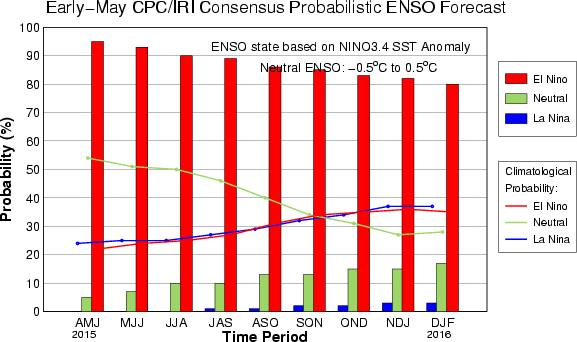
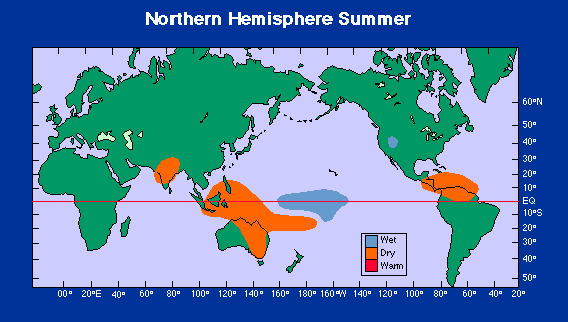

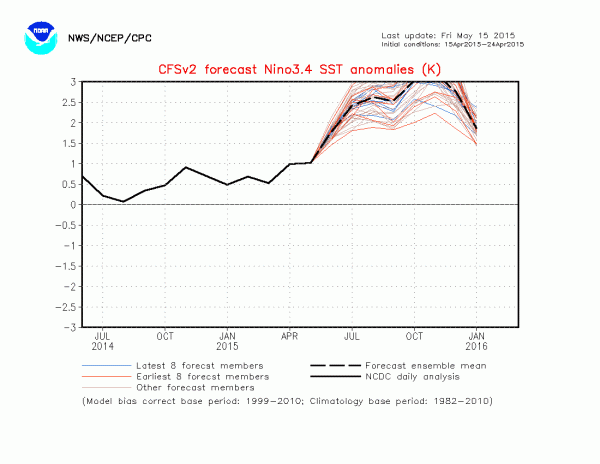
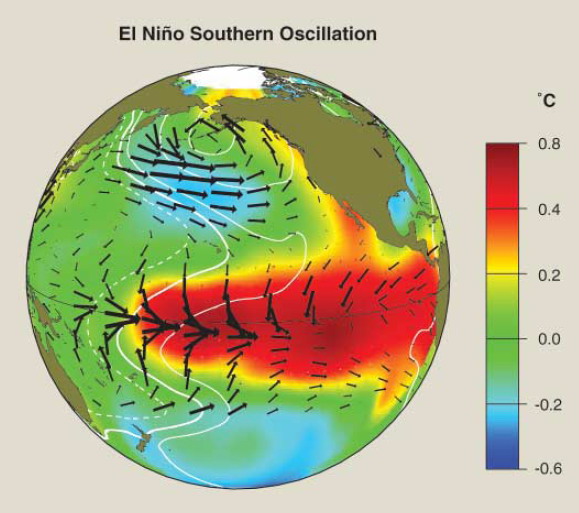






No comments:
Post a Comment
Note: only a member of this blog may post a comment.